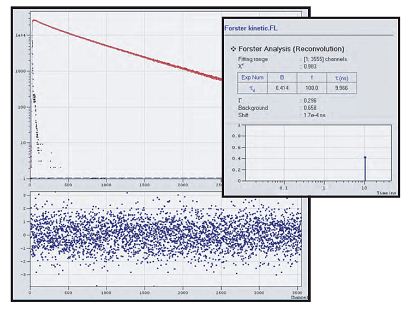
Advanced FAST Software
FAST (Fluorescence Analysis Software Technology) was written for the advanced analysis of fluorescence and phosphorescence decay kinetics.
This software package sets new standards in precision, robustness and speed of data acquisition.
FAST is an add-on to the Fluoracle and F980 (predecessor to Fluoracle) software packages and provides advanced analysis tools for photoluminescence decay kinetics not provided as standard
Download the latest trial version of FAST Software
Product Description
 For the advanced analysis of fluorescence and phosphorescence decay kinetics, Edinburgh Instruments offers the FAST Software package. FAST provides unsurpassed accuracy and fits that are 100% convergent.
For the advanced analysis of fluorescence and phosphorescence decay kinetics, Edinburgh Instruments offers the FAST Software package. FAST provides unsurpassed accuracy and fits that are 100% convergent.
FAST contains a library of advanced data reconvolution and curve fitting routines based on proprietary data processing algorithms, which in both speed and reliability surpass the conventional Marquardt-Levenberg algorithm.
The user can have complete confidence in the quality and reproducibility of the analysed data as it has been comprehensively tested with real and simulated data for validation. Despite the sophisticated and challenging analysis models, FAST is easy to operate, with an intuitive and user friendly interface. A wide range of data input, on screen visualisation, hardcopy and clipboard facilities are available.
Experimental data can be analysed one at a time or in batch mode. The latter is particular useful for larger data sets such as in assay development and screening.
The variety of analysis models comprises:
– Discrete Component Analysis of up to 4 exponential terms with no initial estimates required
– Distribution of Lifetime Analysis with a “grid” of up to 200 lifetimes
– Global Lifetime Analysis for data file formats and fit parameter options
– Stretched Exponential Component Analysis
– Förster Kinetics and Micellar Quenching
– 5 different Time-Resolved Fluorescence Anisotropy decay models
Technical Specifications
| Advanced Analysis Tools of FAST (not provided as standard) |
|---|
| Lifetime distribution analysis |
| Exponential components analysis |
| Support plane analysis for the calculation of lifetime confidence intervals |
| Global exponential components analysis |
| Stretched exponential components analysis |
| Förster kinetics analysis |
| Micellar quenching kinetics analysis |
| Analysis of time resolved fluorescence anisotropy kinetics |








